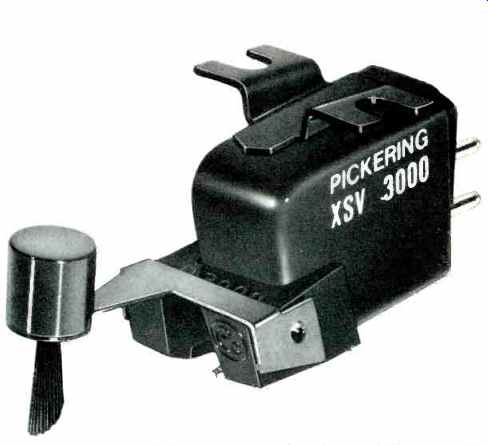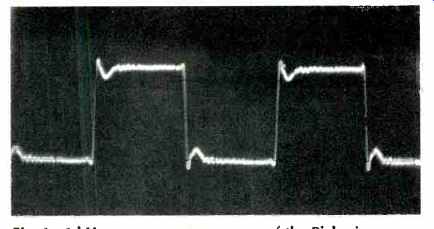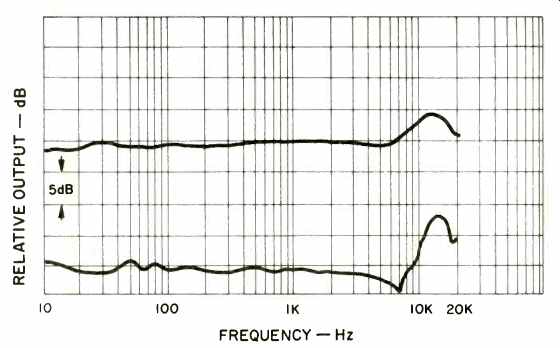
MANUFACTURER'S SPECIFICATIONS:
Stylus Description: Stereohedron.
Tracking Force: 1 gram, + 1/4 gram.
Frequency Response: 10 to 30,000 Hz.
Nominal Output: 5.0 mV.
Channel Separation: 35 dB.
Inductance, Each Channel: 350 mH.
Resistance, Each Channel: 700 ohms.
Load Resistance: 47 kilohms.
Load Capacitance: 275 pF.
Accessory Stylus for Monophonic LP Records: D4541.
Accessory Stylus for 78 RPM Records: D4543.
Price: $99.95, with "Dustmatic" brush attached.
Pickering introduced the second American-made CD-4 cartridge, preceded only by their sister company, Stanton Magnetics. Experience and continuing research with these very special cartridges led to the design of the remarkable XUV/4500Q cartridge for playing the CD-4 and UD-4 discrete records, as well as stereo and matrixed records. At the time we reviewed the XUV/4500Q, we wondered if a stereo cartridge could be made with an equivalent stereo fidelity using this advanced technology. Physical examination of the XSV/3000 cartridge and its Stereohedron stylus showed the outward appearance to be identical to the XUV/4500Q, and the Stereohedron stylus to be a modified stereo version of the Quadrahedron stylus, but apparently less expensive to produce. The first stereo record we played with the Pickering XSV/3000 cartridge bore out the fact that this was indeed a superb stereo cartridge and a worthy relative of the XUV/4500Q. Subsequent listening confirmed our original reaction-the Pickering XSV/3000 is a perfect match, in stereo, for the established quadraphonic XUV/4500Q cartridge for those not wishing to spend the additional sum for a four channel cartridge.
Measurements
As is our practice, measurements are made on both channels, but only the left channel is reported. During the test period the average room temperature was 70°F ± 1° (21°C) and the relative humidity 45 percent ±3 percent.
Frequency response, using the B & K QR-2009 test record and our reference tonearm, an Audio-Technica AT -1009, is flat within 1 dB from 20 Hz to 7 kHz, then slowly rises to a peak of ±3.5 dB at 12.5 kHz, descending to ±1 dB at 20 kHz.
The optimum tracking force for the cartridge we tested was 1.2 grams, with an optimum anti-skating force of 1.5 grams.
Separation was 21.5 dB at 1 khz, 25 dB at 7 kHz, and 17.5 dB at 20 kHz. The load resistance and capacitance, respectively, was 47,000 ohms and 278 pF. Square waves show some ringing that dies rapidly, indicating that the ripples are well damped. The light spacing of the ripples establishes the resonant peak to be well beyond 20 kHz.
The following test records were used in making the reported measurements: Micro-Acoustics TT2002; Shure TTR101, TTR-103, TTR-109, TTR-110; Columbia STR-100, STR-112, SQT-1100; Stereo Review SR -12; B & K QR-2009; Deutsches Hi Fi No. 2; Ovation OVQS/4000; and Nippon Columbia Audio Technical Records (Pulse Code Modulation) XL -7004 6.
Wt. 5.3 g.; d.c. res. 600 ohms; ind. 266 mH; opt. tracking force, 1.2 g.; opt. anti-skating force, 1.5 g.; output, 1.09 mV/1 cm/sec; IM dist. (4:1) + 9 dB lateral, 200/4000; 0.9 percent, + 6 dB vertical, 200/4000; 5.4 percent; crosstalk, -28 dB; ch. bal., 0.25 dB; trackability; high freq. (10.8 kHz pulsed), 30 cm/sec; mid-freq. (1000 + 1500 Hz lat. cut), 25 cm/sec; low freq. (400 +4000 Hz lat. cut), 24 cm/sec; Deutsches Hi Fi No. 2: 300 Hz test bands tracked to 43.1 microns (0.00431 cm) horizontal and 43.1 micron (0.00431 cm) vertical; passed all bands of the Shure TTR-110 (Era Ill) test record; tracks warped records without difficulty. Passed all bands of the Micro-Acoustics Transient and Tracking test record, TT2002. Using the Denon Pulse Code Modulation Audio Technical Record XL-7004A, we measured the arm cartridge (Audio-Technica AT -1009 arm and the Pickering XSV/3000 cartridge) resonance of 8 dB at 6.5 Hz.
Listening Evaluation
We had our first opportunity to run an A-B test between an established quadraphonic cartridge (XUV/4500Q) and a stereo derivative (XSV/3000), playing identical records. Both appeared to sound identical, which is truly remarkable. Neither cartridge exhibited any difficulty in reproducing recorded glass bells or the 23 Hz organ Pedal note on the Advent 5009 recording: Lemmens Vierne Dupré Widor played by Michael Murray on the organ at the Grace Cathedral, San Francisco. The XSV/3000 also reproduced beautifully some super organ music with Michael Murray playing the Marcel Dupré Organ Recital, Advent 5014. On occasion we noted a minor sibilance on certain voices in the singing mode, e.g., Orff: Carmina Burana-Columbia M33172 and Orff: Catulli Carmina-Philips 6500 815 as well as on some pop records.
We used the identical stereo playback equipment that we listed in the April, 1977, issue of AUDIO on pg. 71 for evaluating the XSV/3000 cartridge. As is our practice, a rigorous listening evaluation was conducted utilizing many of the records listed in our previous reports, e.g. AUDIO, April, 1977, pg. 71. The following additional recordings, which demonstrate quite effectively the ability of the Pickering XSV/3000 cartridge to reproduce them faithfully, were also used. All records were cleaned with the Discwasher and destaticized with the Zerostat.

Fig. 1 -1-kHz square -wave response of the Pickering XSV/3000 cartridge.

Fig. 2--Amplitude-frequency response and
separation from 20 Hz to 20 kHz using the B&K QR-2009 test record.
Stereo
Stanley Clarke: Journey to Love-Nemperor Records NE433
Prokofiev: Lieutenant Kije and Kodaly: Háry János--Netherlands Radio Philharmonic--Dorati--London SPC21146.
J. S. Bach: Suite No. 1 in G Major-Roy Christensen, cellist Gasparo GS102.
Beethoven: Symphony No. 5 and Leonore Overture No. 3--The Chicago Symphony Solti-London CS 6930.
Stokowski Conducts Beethoven Symphony No. 7 and Egmont Overture-New Philharmonic Orchestra-London SPC21139.
Pulse Code Modulation (PCM) Stereo:
Zoltán Kocsis Plays Bartók--Denon PCM OX -7044 -ND (Superb piano sound. This is the most realistic recorded Steinway we've ever heard.)
Direct-to-Disc Recording (Stereo)
The King James Version: Harry James and His Band--Sheffield Lab-3. (Although the sound is good, we regret that this is not the big band sound of Harry James of early fame. Perhaps the arrangements are not written in the same manner as those of yore. His most famous numbers are missing on this record.)
Mono
Caruso--A Legendary Performer--RCA CRMI-1749 (A digital restoration developed by Dr. Thomas G. Stockham, Jr. It is quite gratifying that my suggestion to Dr. Stockham that the laboratory curiosity be put to commercial use, has come to fruition. We introduced Dr. Stockham to RCA Records where he demonstrated the original three Caruso restorations to Peter Munves, Rex Isom, and John F. Pfeiffer; the rest is history.)
SQ
J. S. Bach: The Six Organ -Concerto Sinfonias-E. Power Biggs-Columbia M34272.
Tower of Power: Ain't Nothin' Stoppin' Us Now-Columbia PCQ34302.
QS
Hayden: The Creation-Orchestra of the Ludwigsburger Schlossfestspiele-Gönnenwein-Vox Productions, Inc.QSVBX5214.
Stokowski Overtures--The National Philharmonic Orchestra--PYE Records PCNHX6.
The XSV/3000 played all the records with consummate ease, which certainly speaks well for the Stereohedron stylus principle. The Stereohedron has a large bearing surface which is distributed over a larger portion of the modulated groove, and at the stated optimum tracking force of 1.2 grams, the actual force per unit area is, of course, much less and should significantly contribute to the longevity of recording.
-B. V. Pisha
(Audio magazine, Jun. 1977)
Also see:
Pickering XUV/4500Q stereo phono cartridge (Nov. 1975)
Pickering Model XV-15/750E Stereo Cartridge (Jan. 1970)
Pickering XSV/3000 phono cartridge (Dec. 1976), Pickering phono cartridges (Oct. 1977)
Ortofon MC 2000 Phono Cartridge and T 2000 Transform (Dec. 1984)
Micro Acoustics 630 Phono Cartridge (Mar. 1984)
Phono Equalization Kits--various models (Mar. 1979)
= = = =